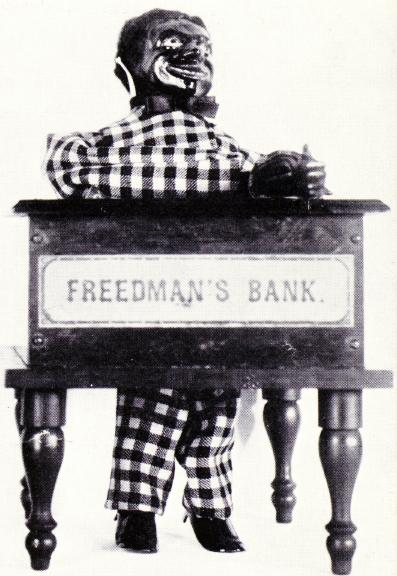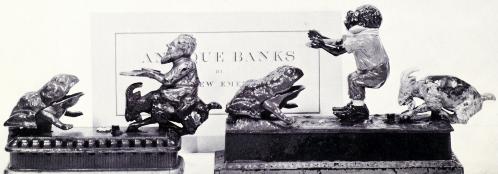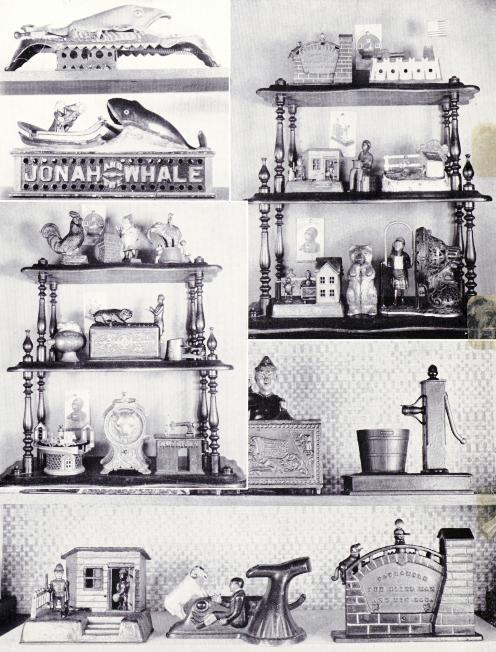|
VAN WERT, OHIO, June 1941
1 ALL-RISK
POLICY COVERS 200 BANKS
Writing one policy to cover 200 banks is a once-in-a-lifetime experience!
But before anyone becomes unduly excited and tries to duplicate the sale in his
territory, perhaps we had best explain that the 200 banks are antique mechanical
banks — that the policy was written by Central Agent George R. Cameron of
Fostoria, Ohio, to cover the unusual collection of Andrew Emerine, President of
the First National Bank of Fostoria — and finally that there are only eight such
collections in the country, so sales opportunities in the field are fairly well
limited.
In our opinion there
could be no more fitting avocation for a bank president than the collection of
antique banks. Especially when — as in the case of Mr. Emerine — the hobby of
collecting is carried out to the point where the collection receives wide
recognition for its completeness. Indeed, Mr. Emerine's collection is regarded
as one of the eight outstanding collections of rare old penny banks in the
United States. The other seven include that of the late Walter P. Chrysler, five
in the east and one other in Ohio. As Mr. Emerine says, "It is not difficult to
gather in a collection of the first 100 of the more common banks, but it is
quite difficult to acquire the last 50 after the collection has reached 200 in
number."

(Figure A) Above is illustrated one of the survivors of the
Freedman bank,
produced just after the Civil War.
The manufacture of toy mechanical banks was a thriving industry back in the good
old days when thrift was a virtue instilled in children at an early age. In
fact, several enterprising iron foundrys carried on spirited competition in
their efforts to produce the most attractive, best selling mechanical banks.
Over 600 different varieties were designed with thousands of duplicates being
retailed between the years 1860 and 1885. Some 260 of these had moving parts and
were called "mechanical banks," while the remainder were known as "still banks."
Today, the collectors'
big problem lies in obtaining those models originally reproduced in small
quantities. For such rare specimens there is a ready market at good prices, many
in this group being eagerly "snatched up" at prices ranging from $100 to more
than $300. From Mr. Emerine's large collection, we are showing — with his
permission — a few of extremely interesting specimens.
Figure A shows the famous
Freedman Bank which appeared soon after the close of the Civil War and sold for
$4.50. Today there are but three known survivors of its kind. This model is a
truly "mechanical bank." with a key winding mechanism motivating the action. In
action the coin is swept into the opening in the table with the figure's left
hand, while the right hand raises the thumb to nose with the fingers active and
the head turning with a broad smile. This particular bank, while made and
marketed in the United States, was bought in Mexico City at several times its
original cost, and is today valued at $300.
(Figure
B) Typical of the action furnished by the "mechanical banks" is that of
the
two models shown below. The coin eventually lands in the frog's mouth.

Figure B illustrates two different banks using similar characters. On the left
side "Old Man on Goat and Frog" (value $100), while on the right "Initiating,
First Degree." In both instances the frog receives the coin.
(Figure C) (Figure D Below)
(Figure E)

(Figure F)
Figure C, "Jonah and the Whale." graphically portrayed to the child's mind a
story with which he was familiar. Another "mechanical bank," it's value today is
$100.
Probably the most
valuable specimen in Figure D is the "Merry-Go-Round" (extreme lower left),
valued at $100.
A valuable collector's
item appears in the group illustrated in Figure E. "The Girl Skipping Rope,"
extreme lower right, is valued at $100.
"Blind Man and His Dog,"
lower right in group F, is another rare bank valued at $135.
After looking over these
few examples from Mr. Emerine's collection you will probably agree with the
youngster who remarked "Gee Whiz, Dad, no wonder kids used to save. It was fun
then."
|



